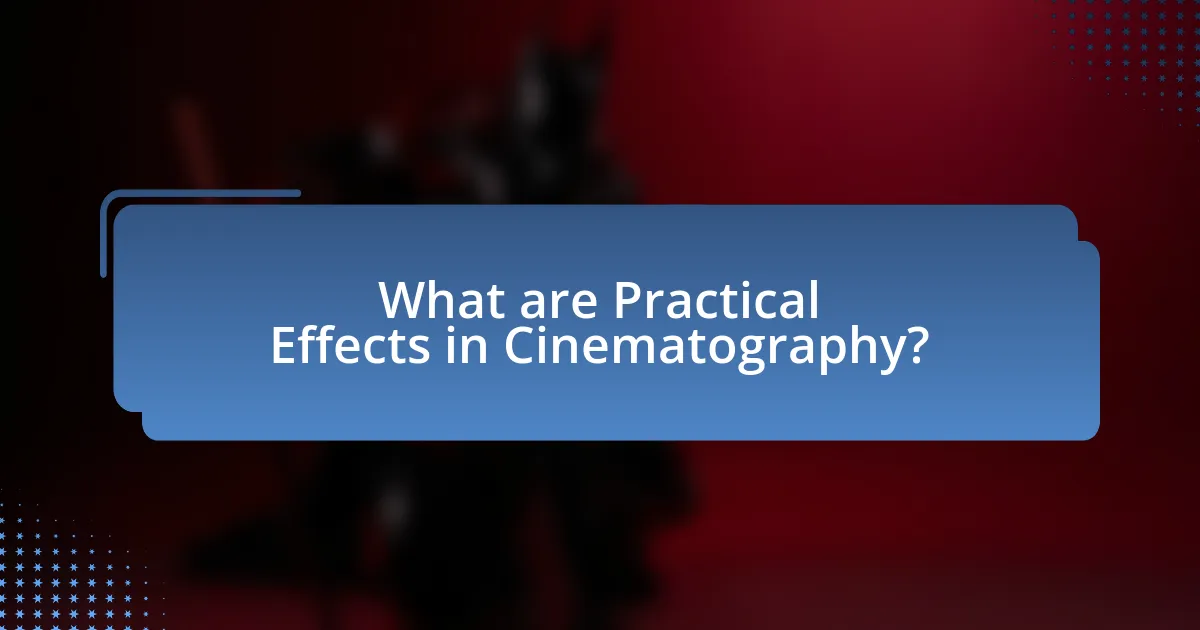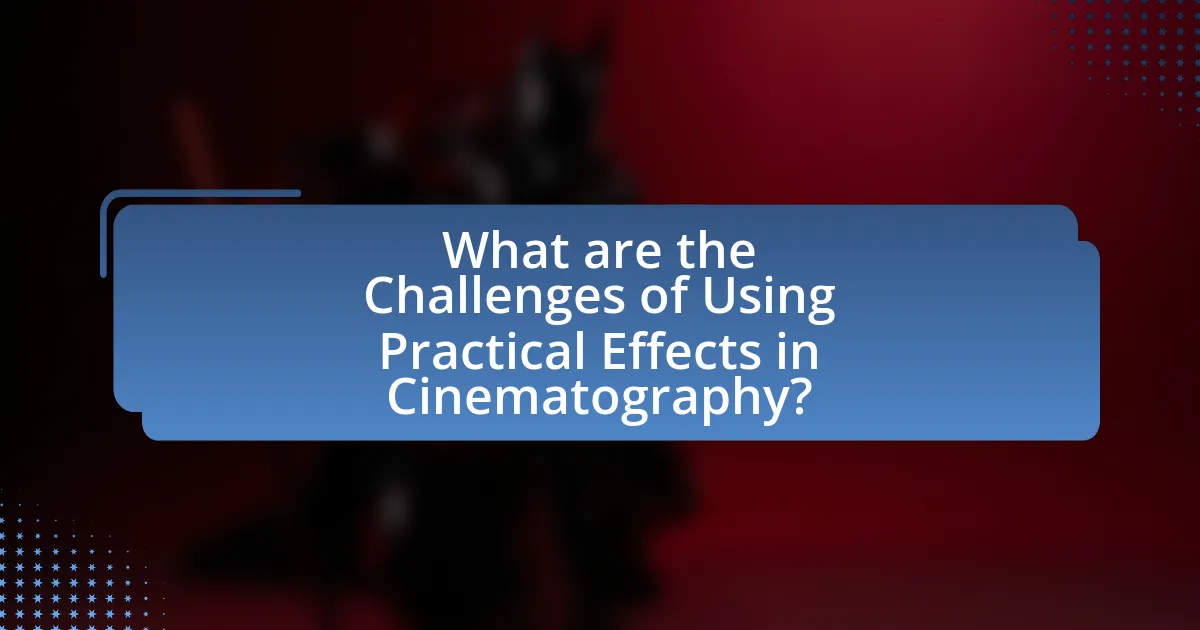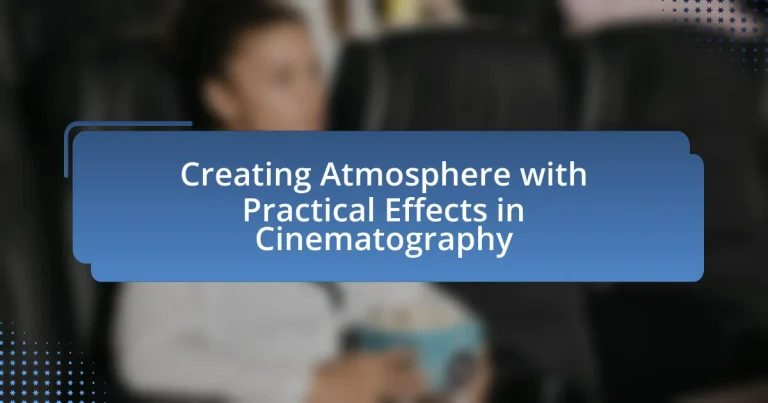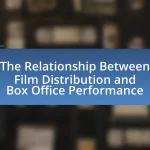The article focuses on the role of practical effects in cinematography and their significance in creating atmosphere within films. It defines practical effects as physical elements produced on set, contrasting them with digital effects generated through computer software. Key advantages of practical effects include enhanced realism, tangible interactions for actors, and a more immersive viewer experience. The article also explores how practical effects contribute to atmospheric elements such as lighting, sound design, and set design, while addressing the challenges filmmakers face in their implementation, including budget constraints and safety considerations. Best practices for effectively integrating practical effects into a film’s overall aesthetic are also discussed, emphasizing the importance of planning and execution.

What are Practical Effects in Cinematography?
Practical effects in cinematography are physical effects created on set during filming, rather than generated through digital means. These effects include techniques such as pyrotechnics, animatronics, and makeup effects, which enhance the realism and immersion of a scene. For instance, the use of practical effects in films like “Jurassic Park” showcased lifelike animatronic dinosaurs, contributing to the film’s critical acclaim and audience engagement. Practical effects often provide tangible interactions for actors and can create a more authentic atmosphere, as evidenced by their historical use in classic films, which relied heavily on physical effects to captivate audiences.
How do Practical Effects differ from Digital Effects?
Practical effects differ from digital effects in that practical effects are physical, tangible elements created on set, while digital effects are generated through computer software. Practical effects, such as animatronics, makeup, and miniatures, provide a real-world presence that can enhance the authenticity of a scene, as evidenced by films like “Jurassic Park,” where animatronic dinosaurs were used alongside digital effects to create a more believable experience. In contrast, digital effects allow for greater flexibility and creativity in post-production, enabling filmmakers to create complex visuals that may be impossible to achieve practically, as seen in movies like “Avatar,” which relied heavily on CGI to create its immersive world.
What are the advantages of using Practical Effects over Digital Effects?
Practical effects offer tangible advantages over digital effects, primarily in their ability to create authentic physical interactions and enhance viewer immersion. Practical effects, such as animatronics or pyrotechnics, provide real-world textures and movements that digital effects often struggle to replicate convincingly. For instance, films like “Jurassic Park” utilized animatronic dinosaurs, which contributed to a more believable interaction with actors, as evidenced by the film’s critical acclaim and lasting impact on visual effects standards. Additionally, practical effects often require less post-production work, allowing for a more streamlined production process. This efficiency can lead to cost savings and a quicker turnaround time for filmmakers.
In what scenarios are Practical Effects preferred in filmmaking?
Practical effects are preferred in filmmaking when authenticity and realism are paramount, particularly in genres like horror, action, and fantasy. These effects provide tangible elements that actors can interact with, enhancing their performances and the overall immersion for the audience. For instance, films such as “The Thing” and “Mad Max: Fury Road” utilized practical effects to create visceral experiences that CGI often struggles to replicate. Additionally, practical effects can be more cost-effective and time-efficient in certain scenarios, especially when considering the need for extensive post-production work associated with digital effects.
Why is Atmosphere Important in Cinematography?
Atmosphere is crucial in cinematography because it shapes the emotional tone and visual storytelling of a film. The atmosphere influences how audiences perceive characters and narratives, enhancing engagement and immersion. For instance, the use of lighting, color palettes, and sound design can evoke specific feelings, such as tension or nostalgia, which are essential for effective storytelling. Studies have shown that films with strong atmospheric elements often receive higher audience ratings, indicating that atmosphere significantly impacts viewer experience and emotional response.
How does atmosphere influence audience perception and engagement?
Atmosphere significantly influences audience perception and engagement by shaping emotional responses and enhancing immersion in the narrative. A well-crafted atmosphere can evoke specific feelings, such as tension, joy, or nostalgia, which directly affects how viewers interpret the story and connect with characters. For instance, research by the University of Southern California found that atmospheric elements like lighting, sound, and set design can alter viewers’ emotional states, leading to increased engagement levels. This indicates that when filmmakers utilize practical effects to create a compelling atmosphere, they can effectively guide audience reactions and foster a deeper connection to the cinematic experience.
What elements contribute to creating atmosphere in film?
Elements that contribute to creating atmosphere in film include lighting, sound design, set design, and color palette. Lighting sets the mood and can evoke emotions; for example, low-key lighting creates tension, while high-key lighting conveys happiness. Sound design enhances the atmosphere through music and sound effects, influencing audience perception and emotional response. Set design establishes the physical environment, providing context and authenticity, while the color palette influences the emotional tone, with warm colors often evoking comfort and cool colors suggesting unease. These elements work together to immerse the audience in the film’s world, shaping their experience and emotional engagement.

How can Practical Effects Enhance Atmosphere in Cinematography?
Practical effects enhance atmosphere in cinematography by providing tangible, real-world elements that create a more immersive experience for the audience. These effects, such as physical explosions, animatronics, and makeup, contribute to a sense of realism that digital effects often struggle to replicate. For instance, films like “The Thing” (1982) utilized practical effects to create visceral horror, which intensified the emotional response of viewers. The tactile nature of practical effects allows for natural interactions with light and shadow, further enriching the visual storytelling. Studies have shown that audiences often perceive practical effects as more authentic, leading to a deeper emotional connection with the film.
What types of Practical Effects are commonly used to create atmosphere?
Common types of practical effects used to create atmosphere include smoke, fog, rain, and lighting effects. Smoke and fog are often generated using machines that disperse vapor, enhancing depth and mood in scenes. Rain effects can be created with water rigs that simulate precipitation, adding realism and emotional weight. Additionally, controlled lighting effects, such as colored gels or practical light sources, can dramatically alter the ambiance, influencing the viewer’s emotional response. These techniques have been utilized in various films, such as “Blade Runner” for its iconic rain-soaked streets and “The Fog” for its eerie atmosphere, demonstrating their effectiveness in atmospheric storytelling.
How do lighting effects contribute to atmospheric creation?
Lighting effects significantly contribute to atmospheric creation by influencing mood, depth, and perception in visual storytelling. For instance, soft lighting can evoke a sense of warmth and intimacy, while harsh lighting may create tension or unease. Studies in cinematography demonstrate that the color temperature of light affects emotional responses; warmer tones often elicit feelings of comfort, whereas cooler tones can induce feelings of isolation. Additionally, the use of shadows and highlights can enhance three-dimensionality, making scenes more immersive. This manipulation of light not only shapes the visual aesthetic but also guides audience interpretation and emotional engagement with the narrative.
What role do physical props and set designs play in enhancing atmosphere?
Physical props and set designs significantly enhance atmosphere by providing tangible elements that contribute to the visual storytelling of a scene. These elements create a sense of realism and immersion, allowing the audience to connect emotionally with the narrative. For instance, a meticulously designed set can evoke specific time periods or locations, while props can symbolize themes or character traits, thereby deepening the viewer’s understanding of the story. Research indicates that environments rich in detail can increase audience engagement, as seen in films like “Blade Runner,” where the intricate set design establishes a dystopian atmosphere that is crucial to the film’s identity.
How do Practical Effects interact with Cinematic Techniques?
Practical effects enhance cinematic techniques by providing tangible, real-world elements that filmmakers can manipulate to create immersive experiences. These effects, such as animatronics, pyrotechnics, and makeup, interact with techniques like camera angles, lighting, and editing to establish mood and realism. For instance, the use of practical effects in films like “Jurassic Park” (1993) allowed for lifelike dinosaur interactions, which were complemented by specific camera techniques that emphasized scale and movement, resulting in a more believable atmosphere. This synergy between practical effects and cinematic techniques not only enriches visual storytelling but also engages audiences on a sensory level, making the experience more impactful.
What camera techniques complement Practical Effects for atmospheric impact?
Camera techniques that complement practical effects for atmospheric impact include depth of field manipulation, camera movement, and lighting adjustments. Depth of field can enhance the focus on practical effects, creating a more immersive experience by blurring the background and emphasizing foreground elements. Camera movement, such as tracking shots or handheld techniques, can add dynamism and realism, making practical effects feel more integrated within the scene. Additionally, strategic lighting can enhance the visibility and texture of practical effects, creating shadows and highlights that amplify their presence. These techniques collectively enhance the viewer’s emotional response and engagement with the scene, as evidenced by their frequent use in successful films like “Mad Max: Fury Road,” where practical effects are highlighted through meticulous camera work.
How does sound design enhance the effectiveness of Practical Effects?
Sound design significantly enhances the effectiveness of practical effects by adding an auditory layer that complements and amplifies the visual experience. When sound effects are synchronized with practical effects, such as explosions or creature movements, they create a more immersive environment that engages the audience’s senses. For instance, the sound of a roaring creature can intensify the impact of its physical presence, making it feel more real and threatening. Studies have shown that sound can influence emotional responses; for example, a 2016 study published in the journal “Cognitive Science” found that sound effects can alter viewers’ perceptions of visual stimuli, enhancing their emotional engagement with the scene. Thus, effective sound design not only supports but elevates the realism and impact of practical effects in cinematography.

What are the Challenges of Using Practical Effects in Cinematography?
The challenges of using practical effects in cinematography include limitations in flexibility, higher costs, and potential safety hazards. Practical effects often require extensive planning and setup, which can restrict creative adjustments during filming. Additionally, the materials and labor involved in creating these effects can lead to increased production expenses compared to digital alternatives. Safety concerns also arise, particularly with effects involving pyrotechnics or stunts, necessitating careful coordination and risk management to protect cast and crew. These factors collectively impact the overall efficiency and feasibility of utilizing practical effects in film production.
What are common limitations faced when implementing Practical Effects?
Common limitations faced when implementing practical effects include budget constraints, time restrictions, and technical challenges. Budget constraints often limit the quality and quantity of materials and skilled labor available for creating effects, which can compromise the final outcome. Time restrictions can hinder the development and execution of complex effects, leading to rushed work that may not meet artistic standards. Technical challenges arise from the need for precise coordination between practical effects and other production elements, such as lighting and camera angles, which can complicate the shooting process and require additional resources to resolve.
How can budget constraints affect the use of Practical Effects?
Budget constraints can significantly limit the use of practical effects in cinematography by reducing the resources available for their creation and implementation. When budgets are tight, filmmakers may opt for cheaper alternatives, such as digital effects, which can compromise the authenticity and tactile quality that practical effects provide. For instance, a study by the Visual Effects Society highlights that films with higher budgets tend to utilize more practical effects, as they can afford the materials, skilled labor, and time required for complex setups. Consequently, budget limitations can lead to a reliance on less immersive techniques, ultimately affecting the film’s overall atmosphere and viewer engagement.
What safety considerations must be taken into account with Practical Effects?
Safety considerations with practical effects include the management of hazardous materials, ensuring proper training for personnel, and implementing safety protocols to prevent accidents. Hazardous materials, such as pyrotechnics or chemicals used in special effects, require careful handling and storage to avoid exposure or accidents. Personnel must be trained in the safe use of equipment and materials, as well as emergency response procedures. Additionally, safety protocols, including the use of personal protective equipment (PPE) and clear communication among crew members, are essential to mitigate risks during production. These measures are supported by industry standards and guidelines, such as those from the American Society of Safety Professionals, which emphasize the importance of safety in film production environments.
What are Best Practices for Creating Atmosphere with Practical Effects?
Best practices for creating atmosphere with practical effects include careful planning, effective use of lighting, and integration with the environment. Planning involves pre-visualization and storyboarding to ensure that practical effects align with the narrative and emotional tone of the scene. Effective lighting enhances the realism of practical effects, as it can create depth and mood; for instance, using colored gels can evoke specific emotions. Integration with the environment is crucial, as practical effects should complement the set design and overall aesthetic, ensuring that they feel organic within the scene. These practices are supported by industry standards, such as those outlined in “The Visual Story” by Bruce Block, which emphasizes the importance of visual coherence in storytelling.
How can filmmakers effectively plan and execute Practical Effects for atmospheric purposes?
Filmmakers can effectively plan and execute practical effects for atmospheric purposes by meticulously designing the effects to enhance the narrative and mood of the film. This involves pre-visualization techniques such as storyboarding and concept art to visualize how practical effects will integrate with the overall aesthetic. Additionally, filmmakers should conduct thorough tests of the effects in various lighting conditions to ensure they achieve the desired atmospheric impact on screen.
For instance, the use of smoke or fog can create a sense of mystery or tension, and testing these effects in the actual shooting environment allows filmmakers to adjust the density and distribution for optimal visual results. Historical examples, such as the use of practical effects in “Blade Runner,” demonstrate how atmospheric effects can significantly contribute to world-building and emotional resonance. By combining careful planning with iterative testing, filmmakers can create immersive atmospheres that enhance storytelling.
What tips can enhance the integration of Practical Effects in a film’s overall aesthetic?
To enhance the integration of practical effects in a film’s overall aesthetic, filmmakers should prioritize seamless blending with digital effects and focus on lighting consistency. Seamless blending ensures that practical effects appear natural within the digital environment, as seen in films like “Jurassic Park,” where animatronics were effectively combined with CGI to create a cohesive visual experience. Additionally, maintaining consistent lighting across practical and digital elements helps unify the scene, as demonstrated in “The Thing,” where practical effects were lit to match the surrounding environment, enhancing realism.

